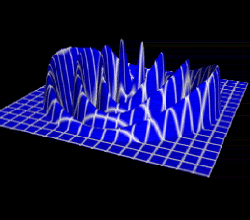Big Spheres to Catch Gravity Waves

According to Einstein’s theory of gravity, an accelerating mass causes the fabric of space-time to ripple in somewhat the same way a skipping rock disturbs the surface of a pond. A new facility in Washington and Louisiana, the Laser Interferometer Gravitational Wave Observatory (LIGO), will soon begin looking for these ripples–so-called gravity waves–but it can only detect a narrow range of frequencies. In the 16 July PRL, an international team proposes a new gravity wave detector made of a pair of spheres, one inside the other. The design would be tough to build but would be sensitive to a wider range of gravitational wave frequencies.
LIGO will initially be tuned to pick up gravity waves in a narrow range of frequencies near 100 Hz, roughly the orbital frequency of a pair of neutron stars in the early stages of a merger. But as the stars spiral toward one another, they spin faster and emit gravity waves at frequencies beyond the peak sensitivity of LIGO. To detect waves from the later stages of such a merger, Livia Conti and Massimo Cerdonio of the National Institute of Nuclear Physics in Padova, Italy, and their collaborators, propose a new design.
The detector would be built of two nested, concentric, metallic spheres separated by a centimeter-wide gap. The outer shell would be most sensitive to gravitational waves with frequencies near 1 kHz, while the gravity wave resonance of the inner sphere would be 2 or3 kHz, depending on the materials. The detector would be sensitive to all gravity waves between the two resonant frequencies. Oscillations induced in the two spheres by a passing gravity wave would be 180 degrees out of phase–one sphere would shrink slightly while the other expanded–causing tiny fluctuations in the gap width. The researchers hope to detect the waves by measuring variations in that width.
Manufacturing 4-m-diameter spheres, suspending them with a precise interior separation, and then cooling them to below 4 K to remove the thermal vibrations, is a huge undertaking, and no one is sure it can be done. Even if the two spheres can be nested, measuring the predicted gap variations of about cm will require new detector technology. Conti and Cerdonio’s team is studying the feasibility of using a handful of laser interferometers embedded in the gap to watch the spheres shrink and stretch.
“They will need something one hundred times better than the detectors we now have,” says MIT’s Rainer Weiss, a member of the LIGO team. With this and other technical hurdles to surmount, Weiss believes that future detectors placed in LIGO (to be called LIGO-2) will be more sensitive than the nested sphere detector at 1 kHz and that the future of gravitational wave detection lies with large interferometers. But he still supports launching pilot programs to test the new detector idea. “If everything goes as planned, I think the incremental technology of LIGO-2 is a better bet,” says Weiss, “but if something goes wrong, [conti’s] proposal could get very interesting.”
–Mark Sincell
Mark Sincell is a freelance science writer based in Houston, TX.


